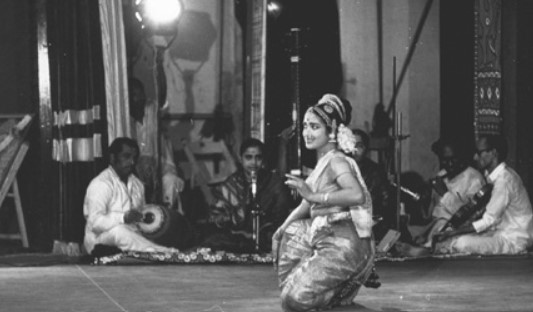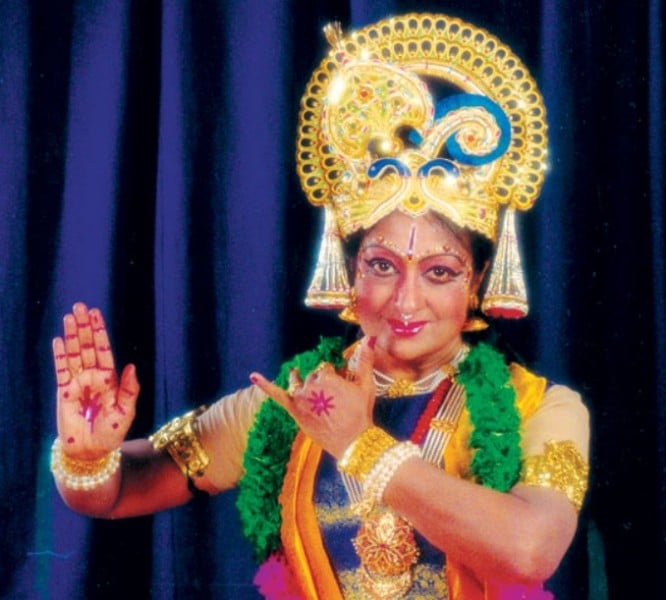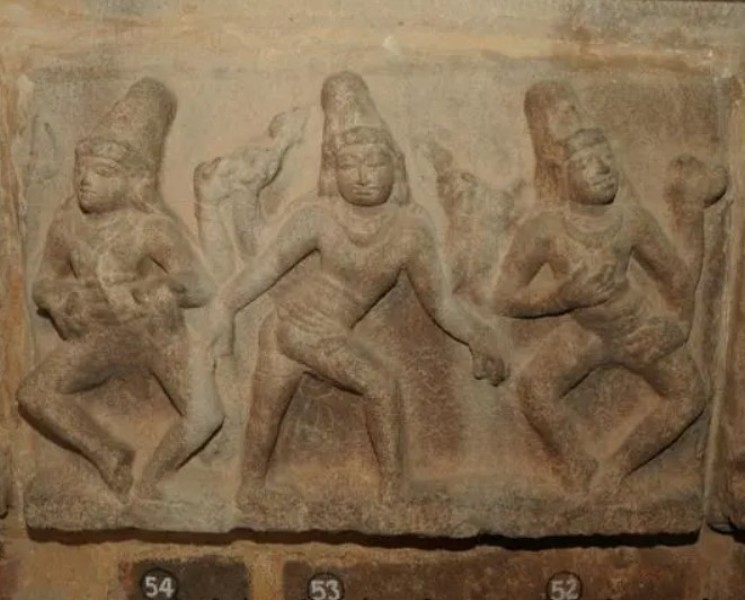Padma Subrahmanyam Height, Age, Husband, Family, Biography & More
Quick Info→
Hometown: Chennai, Tamil Nadu
Age: 80 Years
Religion: Hinduism
| Bio/Wiki | |
|---|---|
| Profession(s) | • Classical Dancer • Teacher/Guru • Singer • Choreographer • Author • Scholar |
| Known for | • Leading exponent of Bharatanatyam • Founder of Bharata Nrithyam |
| Physical Stats & More | |
| Height (approx.) | in centimeters- 173 cm in meters- 1.73 m in feet & inches- 5’ 8” |
| Weight (approx.) | in kilograms- 65 kg in pounds- 143 lbs |
| Eye Colour | Black |
| Hair Colour | Black |
| Career | |
| Awards, Honours, Achievements | • Bharatiyar Award by Vaanavil Panpaattu Maiyam on 12 December 2010 • Lifetime Achievement Award by Nungambakkam Cultural Academy on 5 December 2010 • Felicitation at the International Film Festival India (IFFI) at Goa on 27 November 2010  • Honorary Fellowship by The Asiatic Society of Mumbai on 26 November 2010 • Arsha Kala Bhushanam by Pujyasri Swami Dayananda Saraswati on 7 November 2010 • Honorary Doctor of Letters (D.Litt) by SASTRA University, Thanjavur • Padma Sadhana by Padma Sarangapani Cultural Academy, Chennai • Nritya Kovidha by Naadabrahmam, Chennai • Zee Astitva Life Time Achievement Award by Zee TV & Archana Trust, Mumbai (Maharashtra) • Melvin Jones Award by Lions Club of Madras Melvin Jones  • National Eminence Award by Sri Shanmukhananda Sangeetha Sabha, Mumbai (Maharashtra) • Natya Vidya Nidhi by Andhra Music Academy, Secunderabad (Andhra Pradesh) • Honorary Doctorate by Open University for Alternative Medicine, Kolkata (West Bengal) • Ojaswini Award by Ojaswini Magazine, Bhopal (Madhya Pradesh) • Satabdhi Nartaki at a felicitation function in Mumbai (Maharashtra)  • Chowdiah Award by Academy of Fine Arts, Bangalore (Karnataka) • Nritya Kalasagara by Kalasagaram, Secunderabad (Andhra Pradesh) • Pragna Puraskar by Pragna Bharati, Hyderabad (Andhra Pradesh) • Gupta Award by Gupta Foundation, Eluru (Andhra Pradesh) • LVR Award by LVR Foundation, Chennai 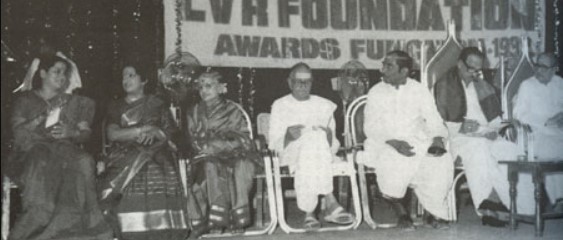 • Ugadi Puraskar by Madras Telugu Academy • Kamban Adippodi Memorial Award by Kamban Kazhagam, Chennai • Sivaji Ganesan Memorial Award by Ganesan's family • Lifetime Achievement Award by Rotary Club of Chennai Galaxy • Significant Achievement Award by Rotary Club of Coimbatore Mid Town  • Vocational Excellence Award by Rotary Club of Trichy • For the Sake of Honour Award by the Rotary Club of Madras • Soviet Land Nehru Award by Soviet Land Magazine in 1983 • Silver Jubilee Award of Excellence by Tamil Nadu Brahmin Association  • Bharata Kala Sagara by Shree Bharatalaya, Chennai • Tirumurai Nandana Perarasi by Sekkizhar Mandram, Chennai • Bharatakkalaiarasi by Narada Gana Sabha, Karur • Silver Jubilee Award by Soorya, Trivandrum (for performing in their festival for 25 years) • Natya Kala Sarathy by Sri Parthasarathy Swami Sabha, Chennai • Award of Excellence by Mudhra, Chennai • Viswa Kala Bharati by Bharat Kalachar, Chennai • Vani Kala Sudhakara at Sri Thyaga Brahma Gana Sabha, Chennai 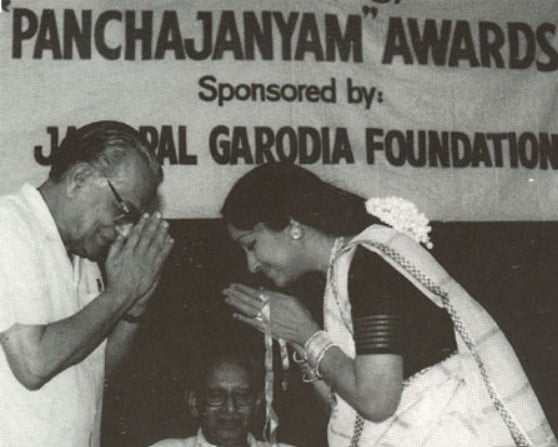 • Natya Padmam by Brahma Gana Sabha, Chennai • Nada Brahmam by Narada Gana Sabha, Chennai • Isai Perarignar by Tamil Isai Sangam, Chennai • Sangeeta Kala Nipuna by Mylapore Fine Arts Club, Chennai • Nritya Kala Siromani by Nungambakkam Cultural Academy, Chennai • Nritya Choodamani by Sri Krishna Gana Sabha, Chennai • Rajiv Gandhi National Integration Award by Indian Bank & Idhayam Publications  • Honorary Fellowship by The Academy of General Education, Manipal University • Kshetra Natyasri Award by Ksetropasana (Prof. Prema Pandurang) • Asthana Vidushi by Sri Krishna Temple, Udupi (first lady recipient in the 765-year-old history of the temple) • Asthana Vidushi by Sri Ananthapadmanabhaswami Temple, Chennai • Thalaikkol Arivai by Kunrakkudi Adeenam • Natya Kalanidhi by Dharmapuram Adeenam • Sri Mata Award by Jagadguru Sankaracharya of Sri Ramachandrapura Matha, Karnataka • Bharata Sastra Rakshamani by Jagadguru Shankaracharya of Kanchi Kamakoti Peetam • Kalidas Samman by Government of Madhya Pradesh  • State Artistes Award by the Government of Tamil Nadu • Kalaimamani by the Government of Tamilnadu • Sangeet Natak Akademi Award by Natak Akademi, New Delhi  • Padma Bhushan by the President of India in 2003  • Padma Shri by the President of India in 1981  • Fukuoka Asian Cultural Prize by Fukuoka, Japan (Dr Padma is the first dancer in the world to receive this prestigious award for 'her contribution to development and harmony in Asia')  • Kambarasa Nartana Vilasa Vittagi by Colombo Kamban Kazhagam, Srilanka • K. M. Munshi Centenary & Bhavan's Golden Jubilee Award by Bharatiya Vidya Bhavan, London, UK • Award of Excellence by New York Tamil Sangam, USA • Natya Ratnakara by India Fine Arts, Austin, USA • Nritya Jyoti by Austin Tamil Sangam, USA • Nritya Ratnakara by Bhairavi Indian Fine Arts Society, Cleveland, USA • Lifetime Achievement Award by Kalanidhi Fine Arts, Toronto, Canada • Lifetime Achievement Award by Soorya, Singapore Chapter • Padma Vibhushan, the second-highest civilian award, on 26 January 2024 |
| Personal Life | |
| Date of Birth | 4 February 1943 (Thursday) |
| Age (as of 2023) | 80 Years |
| Birthplace | Chennai, Tamil Nadu, India (then-Madras Presidency, British India) |
| Zodiac sign | Aquarius |
| Signature |  |
| Nationality | Indian |
| Hometown | Chennai, Tamil Nadu, India |
| School | Nrithyodaya Dance School, Chennai |
| College/University | • Ethiraj College For Women, Chennai • Annamalai University, Tamil Nadu |
| Educational Qualification | • Bachelor's degree in Music • Master's degree in Ethnomusicology • Doctorate |
| Religion | Hinduism |
| Caste | Brahmin [1]Cinemaazi |
| Relationships & More | |
| Marital Status | Unmarried |
| Family | |
| Husband/Spouse | N/A |
| Parents | Father- Krishnaswami Subrahmanyam (Director, Freedom fighter, and Founder of Nrithyodaya Dance School) Mother- Meenakshi Subrahmanyam (Composer, Sanskrit lyricist, and instrumentalist of Veena, Violin, and Harmonium)  |
| Siblings | Brother- two • V. Balakrishnan • S. Krishnaswamy  Sister- none |
| Other Relatives | Sister-in-law- two • Shyamala Balakrishnan • Mohana Krishnaswamy  Nephews- two • Raghuram • B. Kannan Nieces- two • Lata • Gita 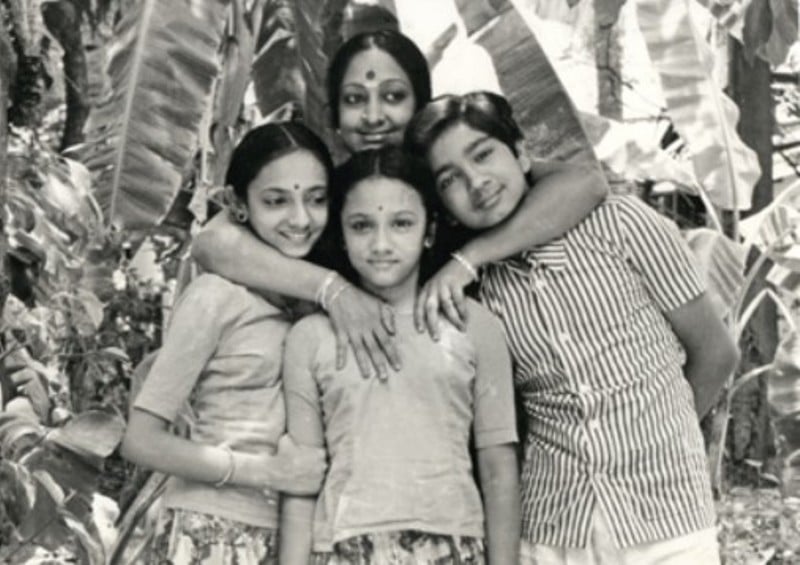 Grandnephews- two • Hrishikesh • Anirudh Ravichander Grandniece- one Gayathri Raghuram |
Some Lesser Known Facts About Padma Subrahmanyam
- Padma Subrahmanyam is an Indian classical dancer, guru, singer, scholar, author, and choreographer. She is a prominent figure in the South Indian classical dance genre Bharatanatyam. She holds the distinction of being the creator of the Bharata Nrithyam art form. She has garnered widespread popularity and has been awarded on numerous occasions. The establishment of Sengol within the newly constructed Indian Parliament building can be attributed to Padma Subrahmanyam’s letter to the Indian Prime Minister’s Office (PMO) in 2021.
- Under the tutelage of Kausalya, she commenced her training in Bharatanatyam and music at Nrithyodaya Dance School in Chennai. She later learnt under Guru Vazhuvoor Ramaiah Pillai.
- Her inaugural on-stage performance (Arangetram) took place in 1956.
- Subsequently, she acquired proficiency in Adavus (the fundamental/initial steps of Bharatanatyam) under the guidance of K. N. Dhandayudapani Pillai and honed her skills in Abhinaya (the art of expression) under the tutelage of Gowri Ammal. She received musical instruction from the renowned classical vocalist B.V. Lakshmanan and the esteemed music director Salil Chowdhury.
- Her thesis for her PhD was in 108 Karanas in Indian Dance & Sculpture, mainly Natya Sastra, and she did her research under the guidance of Padma Bhushan recipient and noted archaeologist, Dr T.N. Ramachandran.
- During her time assisting her brother Balakrishnan with research for a film about temples, she came across dance sculptures called karanas. These sculptures, which portrayed the teachings of the Natya Sastra texts in intricate detail, unexpectedly captivated her interest. As a result, she embarked on a journey into the realm of dance sculpture.
- She read books by scholars like Ananda Coomaraswamy, T. N. Ramachandran, and C. Sivaramamurti with eagerness. Her research focused on the ‘Karanas in Indian dance and sculpture’ found in temples at Chidambaram, Thanjavur, and Kumbakonam. From her dedicated study, she discovered that the 108 Karanas were not just still poses but lively movements.
- Studying literature, sculptures, and inscriptions, and drawing inspiration from her own experiences as a dancer, she diligently reconstructed these movements. Through her remarkable efforts, Padma uncovered the harmonious essence shared by all Indian dances, as described in the Natya Sastra. She generously imparts her knowledge through workshops and camps, showcasing her creativity not only in dance but also in designing exquisite hairstyles, costumes, and jewellery that enhance the allure of the enchanting Karanas.
- Through her expertise as a dancer and choreographer, she has mesmerized audiences with a diverse range of solo and group presentations. These include captivating dance dramas like Meenakshi Kalyanam, Viralimalai Kuravanji, Valli Kalyanam, Silappadikaram, Krishna Tulabaram, Parijata Aharanam, Nagarukku Appal, Geetanjali, Shyama, Sri Gurave Namaha, Pavai Nombu, and a special performance of Vande Mataram, paying homage to India’s Golden Jubilee of Independence.
- Her artistic vision encompasses an expansive dance technique that utilizes the entire body, incorporating graceful leaps, extended leg movements, and swift footwork. This approach magnifies the intricacies of rhythmic expressions, showcasing her remarkable creativity.
- Reviving the Banika style of mono-acting, she has brought forth captivating productions like Krishnaya Tubhyam Namaha, Ramaya Tubhyam Namaha, Jaya Jaya Sankara, and many more. Her commitment to her artistry has earned her well-deserved acclaim as a distinguished artist in the realm of dance.
- From a young age, her innate singing talent has shone through in numerous Indian and foreign languages. Collaborating with her sister-in-law, Shyamala Balakrishnan, she has made noteworthy contributions to several albums, including ‘Folk Music of Tamilnadu,’ ‘Krishna Tulabharam,’ ‘Nritya Margam,’ ‘Natana Sivanjali,’ and ‘Saivappamalai.’ In a separate album titled ‘Gita Govindam,’ she delivered a captivating rendition of Jayadeva’s Ashtapadis.
- She graciously lent her melodious voice to the dance performances of her disciples, while also being accompanied by Dr. Gayatri Kannan, the wife of her nephew, as a co-singer.
- Alongside her extensive repertoire of individual compositions, she has also taken on the role of music composer for the majority of her productions. Notably, she incorporated a multinational orchestra for the music in a few dance dramas commissioned by the Singapore Government, showcasing her innovative approach and global artistic collaboration.
- She spearheaded the incorporation of Pushpanjali as a dance piece, establishing a groundbreaking precedent within the dance community. Notably, she achieved the remarkable feat of being the first dancer to adapt a Meera Bhajan to suit the grammar of Pada Varnam. Padma’s visionary approach extended further to composing the first-ever Bengali Varnam, featuring soulful lyrics penned by the esteemed Salil Chaudhry.
- At the age of fourteen, she commenced her teaching journey as a teacher at Nrithyodaya Dance School in Chennai. Over time, she ascended to the position of Director, leading the school with her expertise and passion.
- Based on her extensive exploration of Bharatamuni’s ‘Natya Sastra,’ she has evolved a novel pedagogy for body training. Her disciples are exposed to a holistic perspective of dance, encompassing practical, theoretical, emotional, intellectual, and spiritual aspects. Under her guidance, she has trained numerous dancers, teachers, and musicians, including Nattuvangam artists who accompany dance performances.
- Padma, blessed with a divine ordination from the revered Centenarian Sage, Pujyasri Chandrasekharendra Saraswati Swamigal, the 68th Jagadguru Sankaracharya of Kanchi Kamakoti Peetam, embarked on designing a collection of 108 Karana sculptures of Lord Shiva and Goddess Parvati. This sacred task was carried out for the newly constructed temple of Lord Nataraja in Satara, Maharashtra, as per the sage’s divine instructions.
- She created sculptures of the Karanas to depict movements not found in the older temples of Thanjavur, Kumbakonam, and Chidambaram. Using twin figures of Shiva and Parvati, she gave life to each Karana movement.
- Twelve years later, Padma stumbled upon a profound revelation. At the renowned Prambanan temple complex in Central Java, Indonesia, dating back to the 9th century AD, she discovered approximately fifty Karana sculptures. This extraordinary connection, defying the boundaries of time and space, has been meticulously documented in a book authored by Dr. Alessandra, an Italian archaeologist who conducted her Post-Doctoral research under Padma’s mentorship, with support from the British Academy in London.
- Her notable achievement lies in the rediscovery of the ancient artistic principles of ‘Marga,’ a path established by Sage Bharata. Just as Sanskrit coexisted with regional languages, Marga once coexisted with various Indian styles until around five centuries ago. Through meticulous research and exploration, Padma has successfully revived the Marga technique, encompassing the entirety of the Indian subcontinent and extending its influence to other Asian regions.
- Under the banner of ‘Bharata Nrithyam,’ Padma presents her performances, reflecting on her findings with pride. Remarkably, she employs this distinctive communication technique and language to choreograph Bharata Nrithyam recitals in various regional languages including Tamil, Kashmiri, Hindi, Bengali, Oriya, Marathi, Kannada, Telugu, and Malayalam. Demonstrating her artistic finesse, Padma adeptly incorporates songs from foreign languages to showcase the captivating art of ‘Abhinaya.’
- She has authored numerous research papers, books, and articles published in magazines and newspapers. She showcased her multi-faceted talents by writing the script, composing the music, and starring in the telefilm titled Bharatiya Natya Sastra.
- She has authored a multitude of publications, including renowned works like ‘Bharata’s Art: Then & Now,’ ‘Bharatakkalai Kotpadu,’ ‘Natya Sastra & National Unity,’ ‘Kanchi Mahaswami’s Vision of Asian Culture,’ ‘Valluvarum Vedaneriyum,’ ‘Bhagavat Gita for Dance,’ ‘Legacy of a Legend,’ ‘Karanas – Common Dance Codes of India & Indonesia’ (3 volumes), as well as children’s books such as ‘Epic Stories from Natya Sastra’ and ‘Natya Sastra Itihasa Kadhaigal’ (in Tamil).
- Padma’s remarkable life and contributions are eloquently depicted in the Tamil biography ‘Padma Subrahmanyam Oru Sagaptam’ by Sundari Santhanam. Furthermore, Chamundeswari has extensively studied her exceptional journey and influence in the realm of dance as part of her Master’s Degree dissertation in Sociology. Padma’s extraordinary talent and accomplishments have garnered international recognition, even in the realm of film productions.
- The film ‘Queen of Dance’ hails from Russia, while ‘Padma’ is a production by Film Australia and the Films Division of the Government of India. Notably, NHK, Japan has dedicated a film to her as part of their esteemed ‘Asia’s Who is Who’ series, highlighting her significant contributions to the realm of dance. Dr Christopher Byrski, formerly of Warsaw University, Poland, and later the Ambassador of Poland in India, has honoured Dr Padma by dedicating his research publication titled ‘Concept of Ancient Indian Theatre’ to her.
- In 2023, Padma’s name became widely known across the country when the Indian government announced that Prime Minister Narendra Modi would establish Sengol near the speaker’s chair during the inauguration of the new Parliament building on May 28, 2023.
- According to reports, in 2021, she wrote a letter to the Prime Minister’s Office (PMO) referencing an article from the Tamil magazine Thuglak. She translated the article into English and mentioned that Sengol had been given to India’s first Prime Minister, Jawaharlal Nehru, upon the country’s independence in 1947.
- She talked about her letter and said that she was amazed by the article when she read about the history of Sengol. She said,
It was an article in Tamil that was published in Thuglak magazine. I was very attracted to the content of the article, which was about Sengol. It was about how Chandrasekharendra Saraswati told his disciple Dr Subramaniam about the Sengol (in 1978), who wrote about it in his books. The Sengol, in Tamil culture, has great significance. The umbrella, the Sengol, and the throne are the three objects which actually give you the concept of the reigning power of the king. The Sengol is the symbol of power, of justice. It is not just something that came from 1,000 years ago. It is also mentioned in the Tamil epic, in regards to Chera kings.” [2]India Today [3]India Today
- She has been a member of several important committees such as the General Council of Sangeet Natak Akademi, New Delhi, the National Committee to celebrate the 40th Anniversary of Indian Independence & Jawaharlal Nehru’s Birth Centenary, Academic Council of Indira Gandhi National Centre for the Arts (IGNCA), New Delhi, Trustee of Indira Gandhi National Centre for the Arts (IGNCA), New Delhi, Indo-US Sub-Commission for Education and Culture, and Indian National Commission for Co-operation with UNESCO.
References/Sources:








